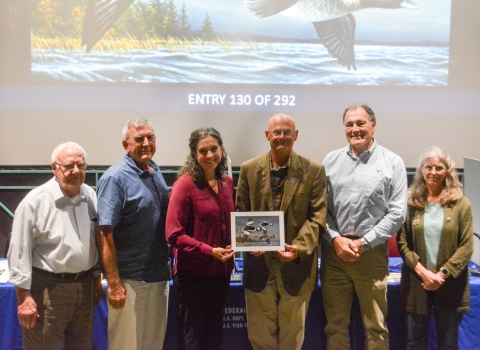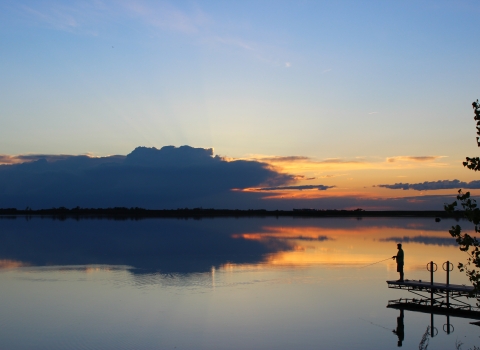HONOLULU — The U.S. Fish and Wildlife Service has announced the publication of the final rule establishing a nonessential experimental population of sihek (Guam kingfisher) on Palmyra Atoll, which is co-managed by The Nature Conservancy and the Service.
Under section 10(j) of the Endangered Species Act, a population of a threatened or endangered species may be designated as an experimental population prior to its (re)introduction. The nonessential experimental population allows the Service to develop tailored take prohibitions that are necessary and advisable to provide the conservation of the species.
Sihek are endemic to the island of Guam but have been extinct in the wild since 1988 due to predation by the brown tree snake. The sihek population, like many other native species, declined following the introduction of the predatory brown tree snake to Guam in the 1950s. Today, only two of Guam’s 12 native forest birds remain in the wild. Currently sihek are managed under human care at Association of Zoos and Aquariums facilities in the continental U.S. and at Guam Division of Aquatic and Wildlife Resources. After the rule goes into effect, captive bred sihek will be released on Palmyra Atoll to increase the global population of the species and to refine release procedures for eventual reintroduction to Guam. This has been an on-going collaborative effort with Guam DAWR, The Nature Conservancy, Association of Zoos and Aquariums, Sedgwick County Zoo, and the Zoological Society of London.
“The designation of an experimental population of sihek on Palmyra Atoll sets the stage for the introduction of this species to the atoll,” said Megan Laut, U.S. Fish and Wildlife Service recovery program manager. “We will learn a lot about the sihek behavior in the wild, on best practices to release them, and will also increase the number of birds that exist on Earth.”
The sihek is a striking cinnamon-brown bird with bright blue wings and tail. It has a long, heavy bill that indicates its predatory feeding behavior. Sihek feed entirely on animal prey including skinks, geckos, spiders, beetles, and land crabs. They are a “sit and wait predator” that perch motionless on exposed branches and swoops down to capture prey off the ground with their bill. They are socially monogamous and pairs share responsibilities such as territory defense, incubation, and chick rearing.
###
The Sihek Recovery Program
The Sihek Recovery Program is a global collaborative of conservationists dedicated to recovering one of Guam’s most iconic native species, the sihek (Guam kingfisher, Todiramphus cinnamominus). Extinct in the wild since 1988 due to the accidental introduction of the invasive brown tree snake, sihek now survive only under human care in a facility run by Guam Department of Agriculture’s Division of Aquatic and Wildlife Resources and at Association of Zoos and Aquariums (AZA) institutions on the US mainland. Until threats on Guam are mitigated, the Sihek Recovery Program is working to identify suitable release locations elsewhere to help grow the global sihek population, safeguard the species against extinction, and refine release methods to support the ultimate goal of returning sihek home to Guam. The Sihek Recovery Program is made up of representatives from the following organizations:
USFWS
The U.S. Fish and Wildlife Service works with others to conserve, protect, and enhance fish, wildlife, plants, and their habitats for the continuing benefit of the American people. For more information, visit www.fws.gov/pacificislands, or connect with us through any of these social media channels at https://www.facebook.com/PacificIslandsFWS, www.flickr.com/photos/usfwspacific/, www.tumblr.com/blog/usfwspacific or www.twitter.com/USFWSPacific.
Guam DAWR
The Guam Department of Agriculture’s Division of Aquatic and Wildlife Resources is dedicated to the conservation, protection and management of Guam’s natural and cultural resources for current and future generations. www.doag.guam.gov/dawr/
ZSL (Zoological Society of London)
Founded in 1826, ZSL (Zoological Society of London) is an international scientific, conservation and educational charity whose mission is to promote and achieve the worldwide conservation of animals and their habitats. The mission is realized through ground-breaking science, active conservation projects in more than 50 countries and two Zoos, ZSL London Zoo and ZSL Whipsnade Zoo.
The Nature Conservancy
The Nature Conservancy is a global non-profit organization dedicated to conserving the lands and waters on which all life depends. Informed by science and guided by traditional values and practices, TNC applies innovative, nature-based solutions to the world’s toughest challenges so that nature and people can thrive. TNC has forged partnerships to manage 14 preserves and other sites in Hawai‘i and Palmyra Atoll, working with government, private parties and communities to protect Hawaii’s and Palmyra’s forests and coral reefs for their ecological value and for the many benefits they provide to people.
Sedgwick County Zoo
The Sedgwick County Zoo in Wichita, Kansas, is dedicated to inspiring respect and conservation for wildlife and wild places. Home to nearly 3,000 animals of more than 400 different species, SCZ has been recognized with national and international awards for its support of field conservation programs and successful breeding of rare and endangered species. Opened in 1971, it has been ranked among the best zoos in the United States. The Sedgwick County Zoo is a not-for-profit organization, accredited by the Association of Zoos and Aquariums – a global leader in wildlife conservation.





